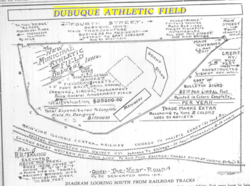Encyclopedia Dubuque
"Encyclopedia Dubuque is the online authority for all things Dubuque, written by the people who know the city best.”
Marshall Cohen—researcher and producer, CNN
Affiliated with the Local History Network of the State Historical Society of Iowa, and the Iowa Museum Association.
DUBUQUE ATHLETIC FIELD
DUBUQUE ATHLETIC FIELD. The Dubuque Athletic Field, also known as the 4th Street Ball Park, on what was known as the Fourth Street Extension between Dubuque and the bridge leading to East Dubuque, was originally a network of sloughs and islands. In the 1850s part of it was platted and became city land. The STANDARD LUMBER COMPANY was allowed to use it for their lumber yards. The land lay neglected until 1912 when Alderman McLaughlin of the Second Ward obtained $2,500 from the city council to convert the property into an athletic park. (1)
Eugene ADAMS, a prominent businessman, with others circulated a petition and raised and raised $8,500. Filling in the sloughs was done with refuse and dirt collected by cleaning the city streets. Debris from the fire-destroyed HOTEL JULIEN included charred lumber, stone and brick. The filling continued in 1913 with more dirt. For the construction of the BASEBALL diamond, loads of rich black dirt were used. (2)
With the field ready, the construction of a grandstand and bleachers became the priority. The grandstand had a capacity of more than 5,000 people. For those willing to pay an additional fee, a raised platform was placed in front of the grandstand on which one hundred opera chairs were placed. Bleachers provided room for an addition 2,000 people. The cost of the construction came to $8,000. In addition to admission, boxes for the two teams were located under the front the grandstand. The exclusive private use of an entire box containing four seats could be purchased for twenty dollars. A single seat in a box for the entire season cost five dollars. Money collected when to the Athletic Field Committee to pay for the chairs. (3)
The Dubuque Athletic Field, "America's first municipally owned athletic field," had its grand opening scheduled for April 28, 1914. (4) On that day, however, rain started to fall early in the morning. "With the gloomy weather came great gobs of gloom for the baseball fans..."
The festivities were rescheduled for Thursday, April 30th.
All factories, business houses, banks
and stores which were to have been
closed on Tuesday afternoon will be
closed on Thursday afternoon, which
will be a half holiday in Dubuque. All
schools in the city, as on Tuesday,
will open at 8:00 Thursday morning and
close at 1:00 in the afternoon so that
all pupils will have the opportunity of
witnessing the parade and the doings at
the athletic park.
Advancing the idea of multiple uses of the area and in efforts to raise money, the management of the field petitioned for and was granted the right to show a carnival on the site from September 29 through October 3, 1914. (5) The application called for an important exception. The management asked that the carnival be permitted without the regular license demanded by the city. The savings were to be used to pay debts from the building of the field. (6) Funds were also raised by selling painted signs on the fence. Football was played as early as 1916 with an admission of twenty-five cents.
Around 1915 the idea of making the area a skating rink was proposed. A warming house able to accommodate two hundred people was built and two large stoves were installed. Two large arc lights, one in the center of the rink were installed with other lighting placed in the grandstands so that the entire rink was illuminated. A small fee was charged for those skating. (7) Certainly one of the most unique uses of the field was for AUTO POLO.
---
Source:
1. "Dubuque's Municipal Park Now Scene of Great Winter Sport," The Telegraph-Herald, January 3, 1915, p. 13
2. Ibid.
3. Ibid.
4. "Dubuque Athletic Field," Dubuque Telegraph-Herald, May 3, 1914, p. 17
5. "Park Employee is First to Benefit," Dubuque Telegraph-Herald'Italic text, September 18, 1914, p. 11
6. "To Hold Carnival at Athletic Field," Dubuque Telegraph-Herald, September 17, 1914, p. 3
7. "Dubuque's Municipal Park..."







